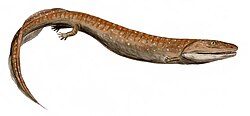| Phlegethontioidea | |
|---|---|
 | |
| Fossil of Pseudophlegethontia turnbullorum in the Field Museum of Natural History. | |
| Scientific classification | |
| Domain: | Eukaryota |
| Kingdom: | Animalia |
| Phylum: | Chordata |
| Clade: | Sarcopterygii |
| Clade: | Tetrapodomorpha |
| Order: | † Aistopoda |
| Clade: | † Phlegethontioidea Anderson et al., 2003 |
Phlegethontioidea is a clade of aistopod tetrapodomorphss including the families Phlegethontiidae and Pseudophlegethontiidae. It is a stem-based taxon defined in phylogenetic terms as all aistopods sharing a more recent common ancestor with Phlegethontia than Oestocephalus . [1]





